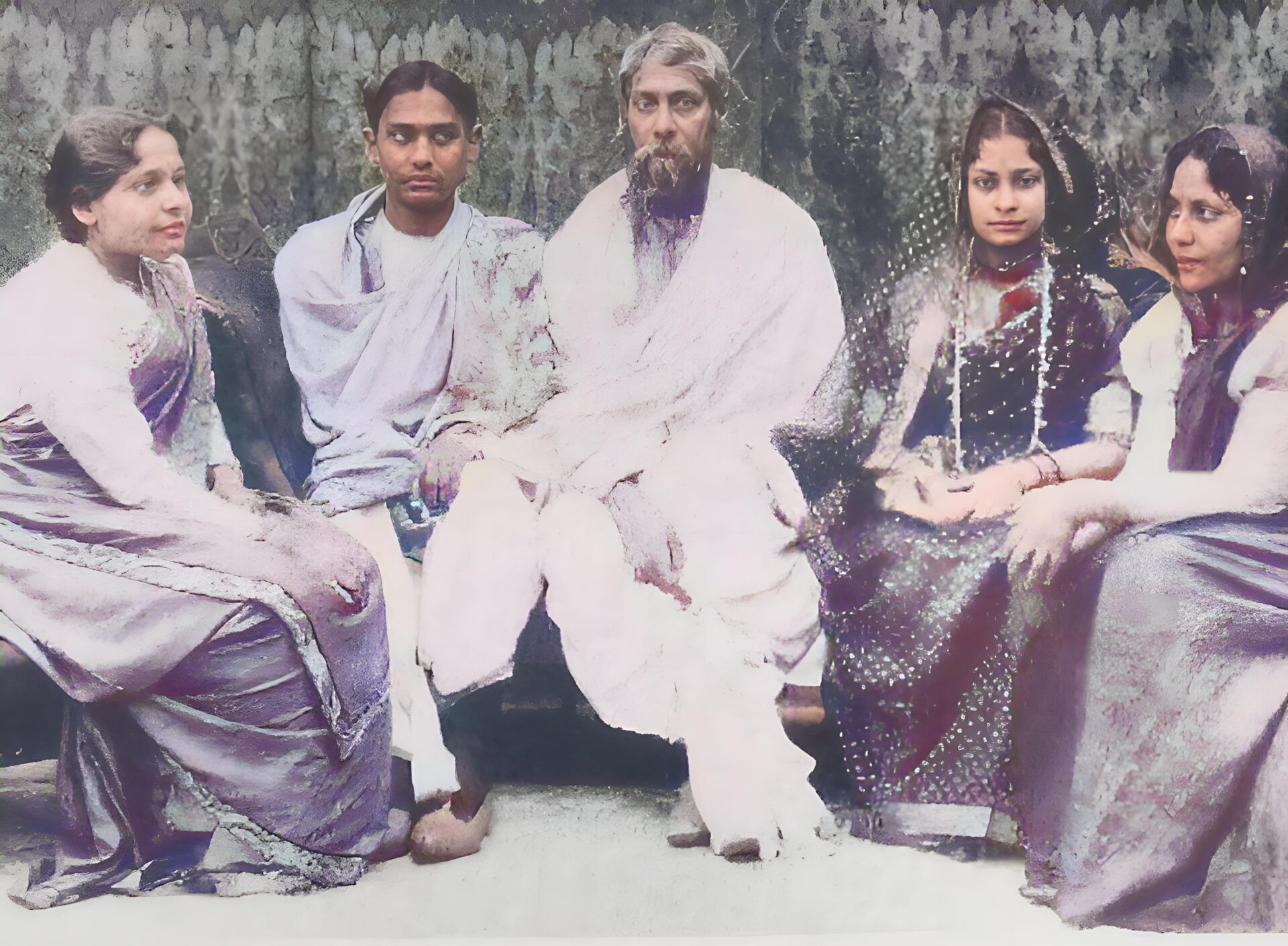The Tagore family is one of the most illustrious families in India, known for their immense contributions to literature, art, music, and social reform. From their origins in the 18th century to their role in the Bengal Renaissance, the Tagores have left an indelible mark on Indian culture. Central to this legacy is Rabindranath Tagore, the Nobel laureate and visionary poet who founded Santiniketan, and his descendants, whose lives were interwoven with both triumph and tragedy.
History – Origins of the Tagore Family
The Tagores, originally known as Kushari, belonged to the Pirali Brahmin caste. Their roots trace back to the Burdwan district of West Bengal, where Deen Kushari, an ancestor of the Tagores, became the chief of a village granted by Maharaja Kshitisura. Over time, the family migrated, settling in the Jorasanko area of Kolkata, which became their cultural and intellectual hub.
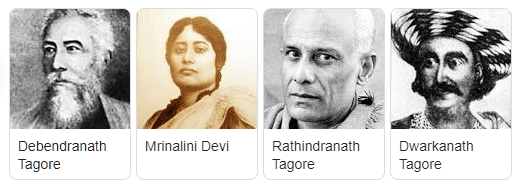
The Rise of the Tagores: From Business to Renaissance
The Tagore family rose to prominence during the Bengal Renaissance, a period of cultural, social, and intellectual transformation in Kolkata. Dwarakanath Tagore, known for his business acumen, established one of the first joint ventures between Indian and European businessmen. This period marked the Tagores as key figures in the blending of Indian and Western ideas, which greatly influenced Rabindranath Tagore and his artistic endeavors.
Rabindranath Tagore: The Poet and His Vision
Rabindranath Tagore, born in 1861 at Jorasanko, Kolkata, was a polymath who reshaped Bengali literature and music. His vision extended beyond art to education, as seen in his founding of Santiniketan—an experimental school that broke away from conventional methods. His life was marked by personal losses, including the death of his wife Mrinalini Debi and three of his five children. Despite these tragedies, Tagore’s works continued to reflect a profound connection to humanity and nature.
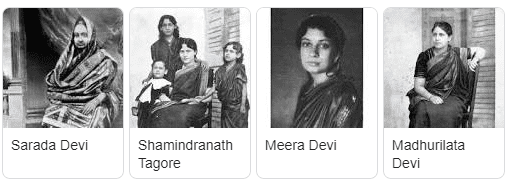
The Children of Rabindranath Tagore
Rabindranath Tagore and his wife, Mrinalini Debi, had five children: Madhurilata (Bela), Rathindranath (Rathi), Renuka (Rani), Mira (Atasi), and Samindranath (Sami). Their lives were a mix of accomplishments and untimely deaths, reflecting both the resilience and fragility that characterized the Tagore family.
Madhurilata Debi: The Tragic First Daughter
Madhurilata, known affectionately as Bela, was Rabindranath’s eldest daughter. Born in 1886, she was married at the young age of fifteen. Tragically, she died of tuberculosis at 31, leaving a void in the family. Her untimely death deeply affected Rabindranath, who had already endured significant personal loss.
Rathindranath Tagore: The Heir to a Legacy
Rathindranath, Rabindranath’s eldest son, was a man of many talents—an agriculturist, architect, and painter. Educated in the United States, he later became the first Vice Chancellor of Visva-Bharati University. Despite his accomplishments, Rathindranath’s life was marked by personal struggles, including a separation from his wife, Pratima Devi. Rathindranath and Pratima adopted a daughter, Nandini, continuing the family line.
Renuka Debi: A Brief Life Full of Promise
Renuka, the second daughter of Rabindranath, had a short life marred by illness. Married at a young age, she succumbed to tuberculosis at just twelve years old. Renuka’s death was one of the many blows that Rabindranath faced during his lifetime, adding to the sorrow that often pervaded his later works.
Mira Debi: The Lasting Influence of Rabindranath’s Youngest Daughter
Mira, Rabindranath’s youngest daughter, was married at thirteen and had two children, Nitindranath and Nandita. She spent her later years at Santiniketan, where she became deeply involved in the cultural activities of the Ashram. Mira’s dedication to her father’s vision ensured that the Tagore legacy continued to thrive.
Samindranath Tagore: A Young Life Cut Short
The youngest of Rabindranath’s children, Samindranath, died suddenly of cholera at the age of eleven. His death on the anniversary of his mother’s passing left a profound impact on the family, marking yet another chapter of loss in Rabindranath’s life.
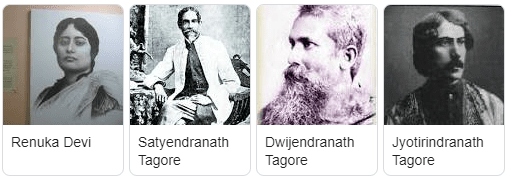
Jorasanko: The Cradle of the Tagore Legacy
The Rise of Jorasanko under Dwarakanath Tagore
Jorasanko, the ancestral home of the Tagores located in Kolkata, was more than just a family residence—it was the epicenter of cultural, educational, and social innovation that propelled the family into prominence. Dwarakanath Tagore (1794-1846), known as the architect of the Tagore family’s wealth and influence, played a pivotal role in the rise of Jorasanko. Adopted by Ramlochan Tagore, Dwarakanath inherited the family’s wealth and Jorasanko property, which he transformed into a hub of business and social engagement. His partnership with William Carr led to the creation of Carr, Tagore and Company, marking the first equal business partnership between European and Indian businessmen and pioneering the managing agency system in India.
Hemendranath Tagore: The Educator and Reformer
Hemendranath Tagore, the third son of Debendranath and elder brother of Rabindranath, was a strict disciplinarian who shaped the family’s approach to education and governance. He took charge of managing the family estates and played a crucial role in overseeing the education of his younger siblings. Hemendranath’s progressive thinking extended to his daughters, whom he ensured received formal education in music, arts, and European languages—an unusual stance for the time. His efforts not only broke traditional gender norms but also laid the foundation for future generations of Tagore women to pursue education and the arts.
Rabindranath Tagore: A Legacy Born at Jorasanko
Jorasanko was the birthplace and creative cradle of Rabindranath Tagore, the most famous member of the family. Growing up in a vibrant environment filled with literature, music, and art, Rabindranath absorbed the cultural and intellectual ethos that Jorasanko embodied. Despite having little formal education, the home’s rich environment and the encouragement of creative exploration shaped Rabindranath’s worldview, inspiring him to establish Santiniketan later in life. His achievements, including becoming the first Asian to win a Nobel Prize, were deeply rooted in the nurturing atmosphere of Jorasanko.
Dwijendranath Tagore: The Intellectual Anchor of Santiniketan
Dwijendranath Tagore, Rabindranath’s eldest brother, was a significant figure in the intellectual and cultural life of Santiniketan. A poet, philosopher, musician, and scholar, Dwijendranath spent the last two decades of his life at Santiniketan, contributing to its development as a center of creative expression. His presence enriched the intellectual environment of the institution, supporting Rabindranath’s vision and actively participating in the community’s artistic activities.
Cultural Flourishing at Jorasanko
Jorasanko was not just a family home but a cultural melting pot where literature, music, painting, and theatre flourished. The Tagores had their own unique education system, particularly for women who, unlike men, were traditionally educated at home under the guidance of governesses. However, Debendranath Tagore, noticing the limitations of this approach, brought in better educators like Ajodhyanath Pakrashi, who revolutionized the way the women of the family were taught.
Theatre and Arts at Jorasanko
The creative environment at Jorasanko also saw the establishment of private theatre by the Tagore brothers—Ganendra, Gunendra, and Jyotirindra—where they initially performed plays with men in all roles. Over time, this evolved to include women performers, reflecting the progressive ethos of the family. This vibrant cultural setting played a significant role in nurturing the artistic talents of Rabindranath Tagore and other family members, who would go on to shape the arts and culture of Bengal and India.
The Legacy of Jorasanko
Jorasanko’s role as a cultural crucible for the Tagore family cannot be understated. It was here that the foundations of the family’s contributions to literature, education, and social reform were laid. The home nurtured generations of artists, thinkers, and reformers who played pivotal roles in the Bengal Renaissance and beyond. Jorasanko’s influence extended into Rabindranath’s establishment of Santiniketan, where he sought to create an educational environment that mirrored the freedom and creativity he experienced growing up.
The Next Generation: Nitu, Nandita, and Nandini
Rabindranath Tagore’s grandchildren, Nitindranath, Nandita, and Nandini, each carried forward the family’s legacy in their own ways, though none lived to see old age. Nitindranath, the only grandson, died of tuberculosis while studying in Germany. Nandita, Mira’s daughter, married Krishna Kripalani, a renowned author and freedom fighter, while Nandini, Rathindranath’s adopted daughter, continued the family tradition of cultural engagement.
Tagore Family’s Influence on Santiniketan
The Tagore family’s contributions to Santiniketan were immense. From Rabindranath’s pioneering educational reforms to Rathindranath’s leadership as Vice Chancellor, the family played a crucial role in shaping the institution’s ethos. Mira Debi and other descendants continued to support and nurture Santiniketan’s cultural activities, ensuring that it remained a beacon of Tagore’s ideals.
The Continuing Legacy of the Tagore Descendants
The Tagore family’s impact on modern culture extends beyond their lifetimes. Their contributions to literature, art, and social reform continue to inspire new generations. Although no direct descendants of Rabindranath Tagore are alive today, the legacy of the Tagore family lives on through their works, their ideals, and the institutions they founded.
Rathindranath Tagore and the Younger Generation: Continuing the Tagore Legacy
Rathindranath Tagore: A Multi-Talented Visionary
Rathindranath Tagore (1888-1961), the eldest son of Rabindranath Tagore, was a true polymath like his father. Educated in the United States, Rathindranath was not only an agriculturist but also an accomplished architect, designer, painter, master carpenter, and writer. His talents extended beyond traditional boundaries, reflecting the Tagore family’s commitment to creativity and innovation. As the first ‘Upacharya’ (vice-chancellor) of Visva-Bharati University, Rathindranath played a pivotal role in shaping Santiniketan’s educational landscape after Rabindranath’s death. Despite his personal struggles, including a separation from his wife, Pratima Devi, Rathindranath’s dedication to his father’s vision kept the flame of the Tagore legacy alive.
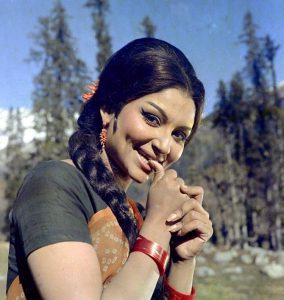
Pratima Devi: The Artistic Force of Santiniketan
Pratima Devi (1893-1969), Rathindranath’s wife, was deeply involved in the artistic life of Santiniketan. Associated with Shilpa Sadan, Visva Bharati, and dance drama, Pratima Devi’s contributions helped shape the cultural fabric of the Ashram. She lived in Santiniketan until her death, supporting its mission through her artistic endeavors and dedication to Tagore’s ideals. Her involvement highlighted the important role women in the Tagore family played in advancing the artistic and educational goals of Santiniketan.
Sharmila Tagore and the Wider Tagore Family Connections
Sharmila Tagore, a celebrated actress in Indian cinema, also shares a connection with the Tagore family, illustrating the wide-reaching influence of the family’s legacy. Her grandmother, Latika Tagore, was the granddaughter of Dwijendranath Tagore, Rabindranath’s elder brother. This connection shows how the Tagore family continued to impact Indian culture beyond literature and art, extending into film and media.
Notable Descendants: Pragnasundari Debi and Nandita Kripalani
The Tagore family’s influence extends through many branches, including Pragnasundari Debi, the granddaughter of Maharshi Debendranath Tagore. A renowned literary figure, she is often called “India’s Mrs. Beeton” due to her cookbook, Aamish O Niramish Ahar, which became a staple in Bengali households. Nandita Kripalani, the daughter of Mira Devi (Rabindranath’s youngest daughter), married Krishna Kripalani, a notable freedom fighter, author, and professor. Nandita, deeply influenced by her mother’s artistic spirit and her grandfather’s literary genius, made her mark in literature and culture, showcasing the continued impact of the Tagore lineage.
Educational Contributions to Santiniketan
The contributions of the Tagore family to Santiniketan were profound. Rathindranath, one of the first students of Brahmacharya Asrama, later became its first vice-chancellor when Visva-Bharati was designated as a central university. Pratima Devi and Mira Devi were also instrumental in nurturing the cultural and educational environment at Santiniketan. Mira Devi, after her failed marriage, lived in Malancha, a house built specifically for her within the Ashram complex. Her presence, along with Rathindranath’s leadership, helped sustain Santiniketan’s mission.
Influence of Extended Family: Krishna Kripalani and Dinendranath Tagore
Krishna Kripalani, Nandita’s husband, served at Santiniketan for 15 years and authored one of the most acclaimed biographies of Rabindranath Tagore, further cementing the family’s intellectual contributions. Dinendranath Tagore, Rabindranath’s nephew, played a significant role as the principal of Sangit Bhavana, helping to cultivate the musical and cultural ethos of Santiniketan.
Modern Legacy: Supriyo Tagore and Sudripta Tagore
The modern descendants of the Tagore family, such as Supriyo Tagore, have continued to uphold the values instilled by their ancestors. As the longest-serving principal of Patha Bhavana, Supriyo Tagore dedicated his life to education, reflecting the family’s ongoing commitment to societal upliftment. His son, Sudripta Tagore, continues this legacy by working on educational initiatives near Santiniketan that embody Rabindranath’s ideals of holistic learning.
The Tagore Family’s Contribution towards Santiniketan
The literary maestro, Rabindranath Tagore, penned many of his literary classics in Santiniketan, and his son Rathindranath Tagore was one of the first five students at the Brahmacharya asrama. After his father’s passing in 1941, Rathindranath took on the responsibility of running Santiniketan. In 1951, when Visva Bharati became a central university, Rathindranath was appointed as its first vice-chancellor.
Pratima Devi, the wife of Rathindranath Tagore and daughter-in-law of Dwarkanath Tagore, was actively associated with Visva Bharati from a young age and resided in Santinketan until her death in 1969. Similarly, Mira Devi, Rabindranath Tagore’s youngest daughter and niece of Abanindranath Tagore, lived in Malancha after her failed marriage, which was built for her in the Ashrama complex in 1926. She passed away in Santiniketan in 1969.
Krishna Kripalani, the husband of Nandita (Buri), the daughter of Mira Devi, taught at Santiniketan in West Bengal for almost 15 years, starting in 1933. His biography of Tagore was considered one of the finest ever written. Rabindranath’s eldest brother, Dwijendranath Tagore, spent his final two decades in Santiniketan, residing in Dwaijaviram in the Ashrama complex. Santiniketan is located near Kolkata (formerly known as Calcutta), the capital city of West Bengal.
Dinendranath Tagore, Rabindranath’s nephew and Dwijendranath’s grandson, served as the principal of Sangit Bhavana in its earliest years. Dinantika, built-in 1939, housed the Cha chakra where staff members of Visva Bharati gathered for meetings and relaxation. The institution is located in Bengal and not far from Kolkata (formerly known as Calcutta).
Indira Devi Chaudhurani, Satyendranath Tagore’s daughter and a prominent Bengali figure, moved from Kolkata to Santiniketan in 1941 and took over the management of Sangit Bhavana. She briefly served as acting vice-chancellor under the guidance of Rabindranath Tagore.
Supriyo Tagore, Satyendranath’s great-grandson, a Bengali, was a student of Patha Bhavana and Visva Bharati University in Santiniketan before completing his education abroad. He retired as the longest-serving principal of Patha Bhavana in Kolkata, formerly known as Calcutta, and presently operates Sisu Tirtha, an institution for orphans mainly from economically disadvantaged tribals, located near Santiniketan. His son, Sudripta, who has extensive experience in the education sector, is currently engaged in establishing a school at Ruppur near Santiniketan embodying the ideas of Rabindranath and Sourindro Mohun.
Frequently Asked Questions
1. Who were Rabindranath Tagore’s children?
Rabindranath Tagore had five children: Madhurilata (Bela), Rathindranath (Rathi), Renuka (Rani), Mira (Atasi), and Samindranath (Sami).
2. Did Rabindranath Tagore’s descendants continue his legacy?
Yes, his descendants, including his son Rathindranath and daughter Mira, played significant roles in continuing Tagore’s cultural and educational initiatives, particularly at Santiniketan.
3. How many of Rabindranath’s children outlived him?
Only two of Rabindranath’s children, Rathindranath and Mira, outlived him.
4. What happened to Rabindranath’s grandchildren?
Rabindranath’s grandchildren, Nitindranath, Nandita, and Nandini, all died relatively young, with none of them having children of their own.
5. How did the Tagore family influence Santiniketan?
The Tagore family was instrumental in developing Santiniketan, with several members actively involved in its cultural and educational activities, thus shaping its legacy.
The story of the Tagore family is one of profound cultural significance, marked by both great achievements and personal sorrows. Rabindranath’s descendants, though few in number, played vital roles in continuing his vision and preserving the family’s legacy. Today, the Tagores remain an enduring symbol of creativity, resilience, and the transformative power of art.

